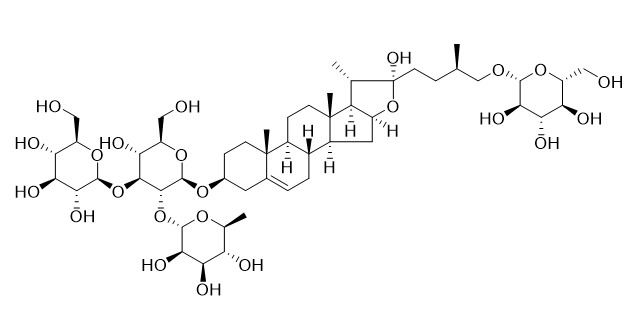Protogracillin
Protogracillin may have inhibitions on platelet aggregation (PAG) and thrombosis.
Inquire / Order:
manager@chemfaces.com
Technical Inquiries:
service@chemfaces.com
Tel:
+86-27-84237783
Fax:
+86-27-84254680
Address:
1 Building, No. 83, CheCheng Rd., Wuhan Economic and Technological Development Zone, Wuhan, Hubei 430056, PRC
Providing storage is as stated on the product vial and the vial is kept tightly sealed, the product can be stored for up to
24 months(2-8C).
Wherever possible, you should prepare and use solutions on the same day. However, if you need to make up stock solutions in advance, we recommend that you store the solution as aliquots in tightly sealed vials at -20C. Generally, these will be useable for up to two weeks. Before use, and prior to opening the vial we recommend that you allow your product to equilibrate to room temperature for at least 1 hour.
Need more advice on solubility, usage and handling? Please email to: service@chemfaces.com
The packaging of the product may have turned upside down during transportation, resulting in the natural compounds adhering to the neck or cap of the vial. take the vial out of its packaging and gently shake to let the compounds fall to the bottom of the vial. for liquid products, centrifuge at 200-500 RPM to gather the liquid at the bottom of the vial. try to avoid loss or contamination during handling.
Molecules.2019, 24(6):E1155
Cell Signal.2024, 124:111467.
Heliyon.2024, 10(11):e32352.
J Food Sci Technol.2019, 56(5):2712-2720
Food and Bioprocess Technology2017, 10(6):1074-1092
Anal Bioanal Chem.2018, 410(5):1561-1569
J Nat Prod.2022, doi: 10.1021
Separations2021, 8(6),80.
J Chromatogr B Analyt Technol Biomed Life Sci.2022, 1203:123307.
Int J Pharmacol2020, 16:1-9
Related and Featured Products
Anticancer Agents Med Chem. 2014;14(6):833-9.
Paris polyphylla: chemical and biological prospectives.[Pubmed:
24917072]
Paris polyphylla J.E. Smith is extensively used in traditional systems of Indian and Chinese medicines mainly for its anticancerous property. The national and international demand for P. polyphylla is constantly increasing and most of the supplies come from wild. Illegal and unscientific exploitation coupled with habitat destruction decreases the natural population of the herb, as a consequence this species comes under vulnerable category. Restoration and conservation of the natural population of this potential herb is prerequisites.
METHODS AND RESULTS:
This article aims to provide an overview on chemical and biological prospective of P. polyphylla. Secondary metabolites such as daucosterol, polyphyllin D, β -ecdysterone, Paris saponins I, II, V, VI, VII, H, dioscin, oligosaccharides, heptasaccharide, octasaccharide, trigofoenoside A, Protogracillin, Paris yunnanosides G-J, padelaoside B, pinnatasterone, formosanin C and 20-hydroxyecdyson saponins have been isolated from P. polyphylla. Several biological activities such as anticancerous, antitumor, cytotoxic, anthelmintic, antimicrobial, antiangiogenic, immunostimulating, contractile and hemostatic have also been reported.
CONCLUSIONS:
Consequently, this review will be helpful to the researcher and scientist for further research.
Fitoterapia. 2010 Dec;81(8):1147-56.
Anti-thrombotic activity and chemical characterization of steroidal saponins from Dioscorea zingiberensis C.H. Wright.[Pubmed:
20659537 ]
Steroidal saponins have long attracted scientific attention, due to their structural diversity and significant biological activities. Total steroidal saponins (TSS) extracted from the rhizomes of Dioscorea zingiberensis C.H. Wright (DZW) constitute an effective treatment for cardiovascular disease. However, the active constituents contained in DZW rhizomes and their pharmacological properties are not fully understood. The aim of this work is to determine and quantify the active constituents in DZW rhizomes using fingerprint technique, and evaluate its anti-thrombotic activity using inferior vena cava ligation thrombosis rat model and pulmonary thrombosis mice model after being gavaged with TSS for 1 or 2weeks.
METHODS AND RESULTS:
In the study, a chemical fingerprint method was firstly established and validated to quantify and standardize TSS from DZW rhizomes including parvifloside, protodeltonin, protodioscin, Protogracillin, zingiberensis saponin, deltonin, dioscin and trillin. TSS extracted from DZW rhizomes were showed to have the inhibitions on platelet aggregation (PAG) and thrombosis, and prolong activated partial thromboplastin time (APTT), thrombin time (TT), and prothrombin time (PT) in a dose-dependent manner in rats. TSS also prolonged the bleeding time and clotting time in a dose-dependent manner in mice.
CONCLUSIONS:
The results indicate that TSS could inhibit thrombosis by both improving the anticoagulation activity and inhibiting PAG action, suggesting that TSS from DZW rhizomes have the potential to reduce the risk of cardiovascular diseases by anti-thrombotic action.



